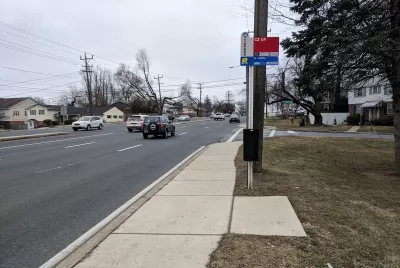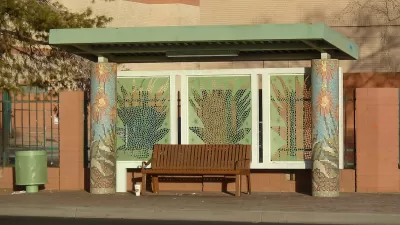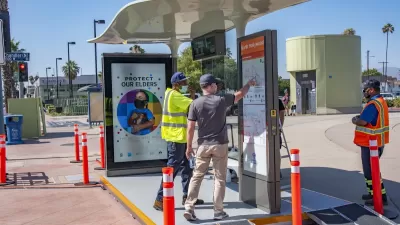Areas most exposed to extreme heat also tend to lack bus shelters and benches at bus stops.

Writing in Greater Greater Washington, Madeleine Bartin outlines the results of her research on how resources are allocated around Washington, D.C.’s transit stops, finding that some of the neighborhoods that experience the hottest temperatures thanks to the urban heat island effect are also least well-equipped with shelters and benches at bus stops.
According to Bartin’s research, “Metro stations with the lowest average percentages of 14-20% of stops having shelters were located entirely in Northeast and Southeast DC. The lines most covered were predominantly located in Northwest DC.”
People who aren’t affected by the design choices may not register them as exclusionary.
In D.C., the Washington Metropolitan Area Transit Authority (WMATA) awards a franchise agreement to Clear Channel Outdoor to build and maintain bus shelters in exchange for advertising space. Because the company is allowed to consider “the advertising market potential” in their site selection, the company is incentivized to see the shelters as revenue boosters rather than as public amenities.
Bartin calls this an issue of spatial justice — “a field of study that acknowledges the impact of urban design and access to public resources.” As Bartin explains, “features of cities that we often take for granted—like shade, heat, and bus stops—are not uniform, or innate, but shaped by human interaction.” The decisions made by policymakers and planners impact who has access to public resources.
FULL STORY: Some of the most sweltering DC neighborhoods lack bus shelters. Cooler spots have them

Planetizen Federal Action Tracker
A weekly monitor of how Trump’s orders and actions are impacting planners and planning in America.

Congressman Proposes Bill to Rename DC Metro “Trump Train”
The Make Autorail Great Again Act would withhold federal funding to the system until the Washington Metropolitan Area Transit Authority (WMATA), rebrands as the Washington Metropolitan Authority for Greater Access (WMAGA).

The Simple Legislative Tool Transforming Vacant Downtowns
In California, Michigan and Georgia, an easy win is bringing dollars — and delight — back to city centers.

The States Losing Rural Delivery Rooms at an Alarming Pace
In some states, as few as 9% of rural hospitals still deliver babies. As a result, rising pre-term births, no adequate pre-term care and harrowing close calls are a growing reality.

The Small South Asian Republic Going all in on EVs
Thanks to one simple policy change less than five years ago, 65% of new cars in this Himalayan country are now electric.

DC Backpedals on Bike Lane Protection, Swaps Barriers for Paint
Citing aesthetic concerns, the city is removing the concrete barriers and flexposts that once separated Arizona Avenue cyclists from motor vehicles.
Urban Design for Planners 1: Software Tools
This six-course series explores essential urban design concepts using open source software and equips planners with the tools they need to participate fully in the urban design process.
Planning for Universal Design
Learn the tools for implementing Universal Design in planning regulations.
Smith Gee Studio
City of Charlotte
City of Camden Redevelopment Agency
City of Astoria
Transportation Research & Education Center (TREC) at Portland State University
US High Speed Rail Association
City of Camden Redevelopment Agency
Municipality of Princeton (NJ)





























